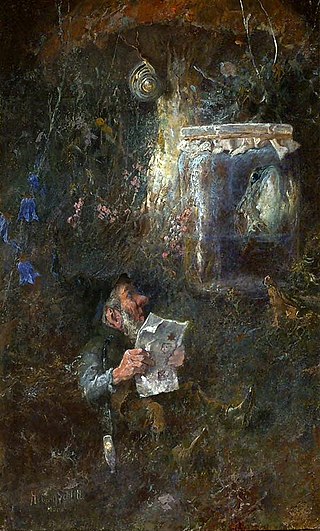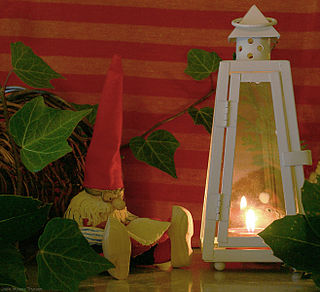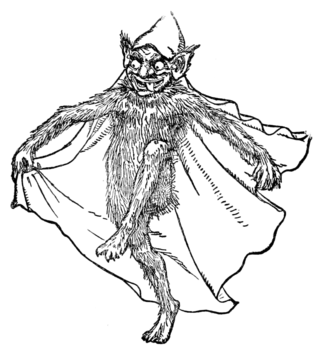Related Research Articles

A gnome is a mythological creature and diminutive spirit in Renaissance magic and alchemy, introduced by Paracelsus in the 16th century and widely adopted by authors including those of modern fantasy literature. Typically small humanoids who live underground, gnome characteristics are reinterpreted to suit various storytellers and artists.

A nisse, tomte, tomtenisse, or tonttu is a mythological creature from Nordic folklore today typically associated with the winter solstice and the Christmas season. They are generally described as being short, having a long white beard, and wearing a conical or knit cap in gray, red or some other bright colour. They often have an appearance somewhat similar to that of a garden gnome.

A kobold is a mythical sprite. Having spread into Europe with various spellings including "goblin" and "hobgoblin", and later taking root and stemming from Germanic mythology, the concept survived into modern times in German folklore.
In Finnish mythology and lore, a menninkäinen is believed to be a leprechaun-like inhabitant of the forests. Fairy tale depictions often involve riddling, dominance struggles and favors elicited. Menninkäinen were probably originally thought to be spirits of dead people, but folklore about them has changed during time, and they turned to be something else.
A hobgoblin is a household spirit, appearing in English folklore, once considered helpful, but which since the spread of Christianity has often been considered mischievous. Shakespeare identifies the character of Puck in his A Midsummer Night's Dream as a hobgoblin.
Fairies, particularly those of Irish, English, Scottish and Welsh folklore, have been classified in a variety of ways. Classifications – which most often come from scholarly analysis, and may not always accurately reflect local traditions – typically focus on behavior or physical characteristics.

The bogeyman is a mythical creature used by adults to frighten children into good behaviour. Bogeymen have no specific appearance and conceptions vary drastically by household and culture, but they are most commonly depicted as masculine or androgynous monsters that punish children for misbehaviour. The bogeyman and conceptually similar monsters can be found in many cultures around the world. Bogeymen may target a specific act or general misbehaviour, depending on the purpose of invoking the figure, often on the basis of a warning from an authority figure to a child. The term is sometimes used as a non-specific personification of, or metonym for, terror, and sometimes the Devil.

In Breton folklore, a Korrigan is a fairy or dwarf-like spirit. The word korrigan means in Breton "small-dwarf". It is closely related to the Cornish word korrik which means gnome. The name changes according to the place. Among the other names, there are korrig, korred, korrs, kores, couril, crion, goric, kornandon, ozigan, nozigan, teuz, torrigan, viltañs, poulpikan, poulpiquet, and paotred ar sabad.

The kallikantzaros is a malevolent creature in Southeast European and Anatolian folklore. Stories about the kallikantzaros or its equivalents can typically be found in Greece, Bulgaria, Turkey, Serbia, Albania, Bosnia, and Cyprus. Kallikantzaroi are believed to dwell underground but come to the surface during the twelve days of Christmas, from 25 December to 6 January.

A spriggan is a legendary creature from Cornish folklore. Spriggans are particularly associated with West Penwith in Cornwall.
The Knocker, Knacker, or Tommyknocker (US) is a mythical, subterranean, gnome-like creature in Cornish and Devon folklore. The Welsh counterparts are coblynau. It is closely related to the Irish leprechaun, Kentish kloker and the English and Scottish brownie. The Cornish described the creature as a little person 2 ft 0 in (0.61 m) tall, with a disproportionately large head, long arms, wrinkled skin, and white whiskers. It wears a tiny version of standard miner's garb and commits random mischief, such as stealing miners' unattended tools and food.
The Simonside Dwarfs, also known as Brownmen, Bogles and Duergar, are in English folklore a race of dwarfs, particularly associated with the Simonside Hills of Northumberland, in northern England. Their leader was said to be known as Heslop.
Bloody Bones is a bogeyman figure in English and North American folklore whose first written appearance is approximately 1548. As with all bogeymen the figure has been used to frighten children into proper deportment. The character is sometimes called Rawhead, Tommy Rawhead, or Rawhead-and-Bloody-Bones.

A lutin is a type of hobgoblin in French folklore and fairy tales. Female lutins are called lutines.

Glashtyn is a legendary creature from Manx folklore.

A duende is a humanoid figure of folklore, with variations from Iberian, Ibero American, and Latin American cultures, comparable to dwarves, gnomes, or leprechauns. In Spanish duende originated as a contraction of the phrase dueñ(o) de casa, effectively "master of the house", or perhaps derived from some similar mythical being of the Visigoth or Swabian culture given its comparable looks with the “Tomte” of the Swedish language conceptualized as a mischievous spirit inhabiting a dwelling.
Mythic humanoids are legendary, folkloric, or mythological creatures that are part human, or that resemble humans through appearance or character. Each culture has different mythical creatures that come from many different origins, and many of these creatures are humanoids. They are often able to talk and in many stories they guide the hero on their journey.
A bluecap is a mythical fairy or ghost in English folklore that inhabits mines and appears as a small blue flame. If miners treat them with respect, the bluecaps lead them to rich deposits of minerals. Like knockers or kobolds, bluecaps can also forewarn miners of cave-ins. They are mostly associated with the Anglo-Scottish borders.

A goblin is a small, grotesque, monstrous creature that appears in the folklore of multiple European cultures. First attested in stories from the Middle Ages, they are ascribed conflicting abilities, temperaments, and appearances depending on the story and country of origin, ranging from mischievous household spirits to malicious, bestial thieves. They often have magical abilities similar to a fairy or demon, such as the ability to shapeshift.
References
- ↑ ""coblynau" in A Dictionary of Celtic Mythology, OUP".
- ↑ Offut, Jason (2019). Chasing American Monsters. Woodbury, Minnesota: Llewellyn Publications. ISBN 978-0-7387-5995-1.
- ↑ Franklin, Anna (2002). "Goblin", The Illustrated Encyclopedia of Fairies. London: Paper Tiger. ISBN 1-84340-240-8. p. 108
- ↑ The Concise Oxford Dictionary of Current English